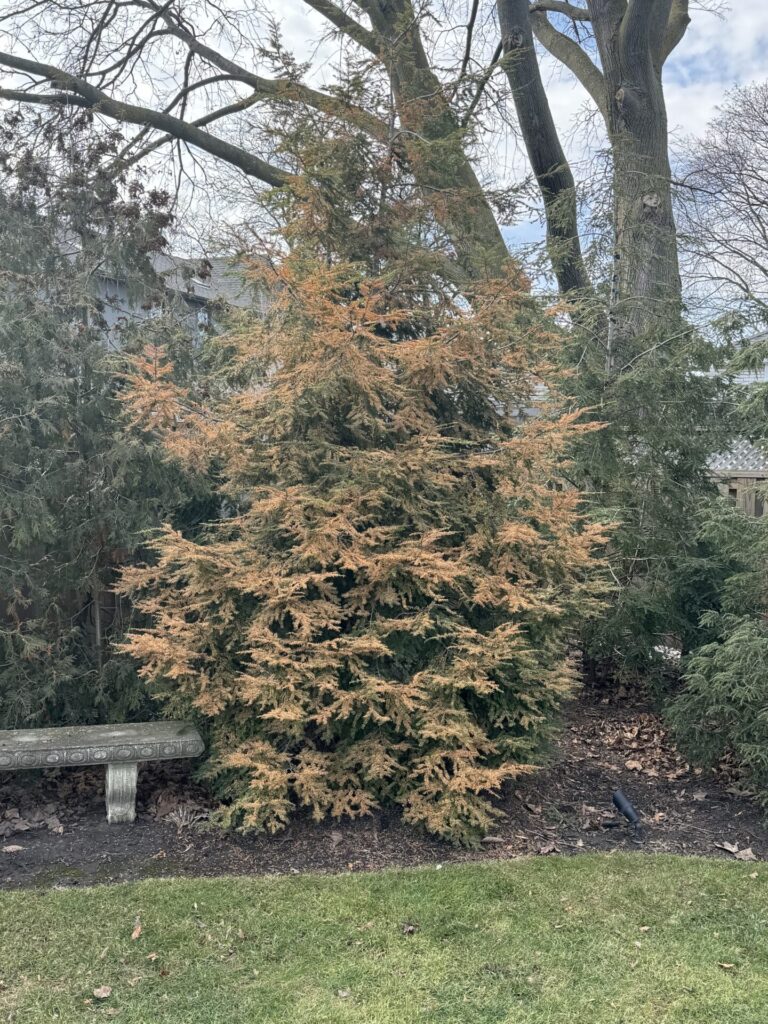
A healthy hemlock has now turned brown. I don’t see evidence of woolly adelgid. The tree is one of three hemlocks and is the only one turning brown. I have attached several photos. Any suggestions?
I’m sorry to hear about your hemlock, it sounds like it has been quite happy over the past several years!
It’s late February, and we’ve had a relatively warm winter, not a lot of rain, but several freeze/thaw periods, where temperatures have increased then plunged quickly, or vice versa. Hemlocks have shallow roots, and environmental stress could be the cause of the entire tree turning brown. Consider if one or more of the following could be factors:
- Dry soil – Check if the tree is thirsty, and for tips on winter watering and mulching: see Ask a Master Gardener. Watering evergreens this winter as it’s been so dry.
- Poorly draining or wet soil – roots can be damaged if they rest in standing water – has there been flooding nearby? Is the water table high? Have there been any changes to drainage, e.g., a sump pump outlet or a downspout placed in the direction of the root zone? Is there a nearby slough or pond that is full?
- Compacted soil – If there has been construction/heavy equipment nearby or the tree is in a spot confined by a driveway or sidewalk, the soil may have been compacted. Compacted soil lacks air spaces, which are needed by roots for uptake of water and nutrients. Often, compacted soil remains wet and can cause root rot.
- Too much sun – Is the tree getting lots more sun than during other seasons? For example, nearby deciduous trees with their bare winter branches could let more sunlight through, which can be drying.
- Wind – High winds can be very drying. Is your tree in an exposed position?
- Salt – Is the tree near a source of salt, e.g., roads, sidewalks? (from your photo, this does not appear to be the case)
- Improper planting – if not planted correctly, root girdling can occur, leading to death of the tree. Your other trees seem to be fine – this is unlikely the cause.
The above list of possible issues is from the University of Saskatchewan. Why is my evergreen turning brown and losing needles?
It is possible that the browning is due to an insect pest. You mention you don’t see evidence of the evil hemlock woolly adelgid (HWA), which feeds on cells that store water/nutrients at the bases of needles. The HWA overwinters on branches and twigs – if these insects were present, the undersides of branches should be covered by what looks like white, woolly tufts. As of October 2023 the HWA has been detected southwest of the GTA, e.g., in the Hamilton and Niagara areas, as well as east of Toronto, in Grafton, which is halfway between Toronto and Kingston. That being said I would expect foliage discolouration from the HWA to happen more gradually – with the needles becoming dry and gray in colour (not brown). From the information you provide, is sounds like the browning has occurred over just a couple of months. There are other insects that feed on hemlock, but these don’t fit the picture you describe, either. See U Kentucky. Common insect pests of hemlock. To be more certain, look on the affected leaves for webbing (spider mites), fungal spores (black, rust coloured). If you check again and feel this is the HWA, please report this to the Invading Species Hotline (1-800-563-7711).
You can check if the tree branches are alive, by scraping away a small area of bark – green means there’s still life.
Finally, as it’s not clear what is wrong with your tree, we don’t know if your other 2 hemlocks could be at risk. I’d suggest contacting an arborist. Landscape Ontario has lists of arborists in various areas of Ontario. It is often very difficult to diagnose plant health problems by photographs. If, as we hope, the tree will recover, an arborist could also prune the dead branches for you.

